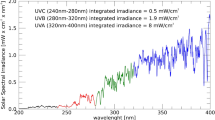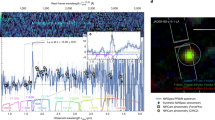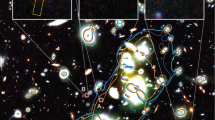Abstract
THE far ultraviolet photometer mounted on Venera-4, launched on June 12, 1967, scanned the sky to measure the ultraviolet radiation from the Milky Way, which was discovered by Kurt1. The observations were made in two spectral intervals, the first including the hydrogen Lyman α line (λ 1050–1340 Å) and the second off the Lyman α line (λ 1225–1340 Å).
This is a preview of subscription content, access via your institution
Access options
Subscribe to this journal
Receive 51 print issues and online access
$199.00 per year
only $3.90 per issue
Buy this article
- Purchase on SpringerLink
- Instant access to full article PDF
Prices may be subject to local taxes which are calculated during checkout
Similar content being viewed by others
References
Kurt, V. G., Astron. Circ. Acad. Sci. USSR, 439, 2 (1967).
Kurt, V. G., and Sunajev, R. A., Astr. Zh., 44, 1157 (1967).
Zimmermann, H., Astro. Nachr., 288, 95 (1964).
Stecher, T. R., Ap. J., 142, 1683 (1965).
Bok, B. I., Observatory, 79, 58 (1959).
Author information
Authors and Affiliations
Rights and permissions
About this article
Cite this article
KURT, V., DOSTOVALOV, S. Far Ultraviolet Radiation from the Milky Way. Nature 218, 258 (1968). https://doi.org/10.1038/218258a0
Received:
Issue date:
DOI: https://doi.org/10.1038/218258a0
This article is cited by
-
Interpretation of Extraterrestrial Lyman-alpha Observations
Nature (1971)
-
Galactic Lyman Alpha and the Interstellar Shock Wave
Nature (1970)



